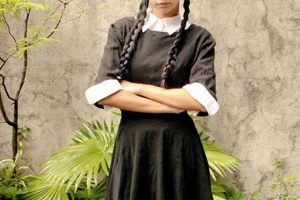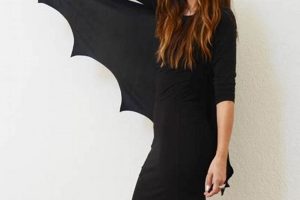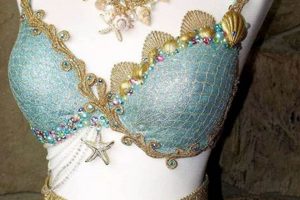The creation of attire inspired by the nineteen eighties, achieved through homemade methods, represents a resourceful approach to replicating the decade’s distinctive fashion trends. Examples include repurposing existing garments, crafting accessories from readily available materials, and employing basic sewing or crafting techniques to emulate iconic looks.
This approach to recreating a specific era’s fashion offers numerous advantages. It provides a cost-effective alternative to purchasing commercially produced items, encourages creativity and resourcefulness, and allows for personalization to achieve a unique and individual style. Historically, the eighties were characterized by bold colors, exaggerated silhouettes, and a do-it-yourself ethos, making it a particularly suitable decade for handcrafted interpretations.
The following sections will examine specific trends prevalent in the nineteen eighties, providing guidance on how these styles can be effectively recreated at home. Attention will be given to sourcing appropriate materials, adapting existing clothing items, and employing crafting skills to achieve authentic representations of the decade’s iconic looks.
Tips for Creating Attire Inspired by the 1980s Through Do-It-Yourself Methods
The following tips aim to guide the creation of apparel reminiscent of the nineteen eighties, utilizing readily available resources and crafting techniques. Adherence to these principles can assist in achieving a more authentic and impactful result.
Tip 1: Embrace Bold Colors and Patterns: The nineteen eighties were characterized by vibrant hues and geometric designs. Prioritize incorporating neon shades, pastel tones, and patterns such as polka dots, stripes, and animal prints into design choices.
Tip 2: Utilize Existing Garments: Examine current wardrobe items for potential modifications. Oversized shirts, denim jackets, and leggings can serve as the foundation for a variety of eighties-inspired looks through simple alterations or embellishments.
Tip 3: Incorporate Shoulder Pads: The exaggerated shoulder silhouette was a defining feature of eighties fashion. Shoulder pads can be easily added to blouses, dresses, and jackets to achieve this characteristic shape. These can be purchased or crafted from layered fabric.
Tip 4: Accessorize Appropriately: Accessories played a crucial role in completing any eighties ensemble. Consider adding items such as large hoop earrings, layered necklaces, fingerless gloves, and scrunchies to enhance the overall aesthetic.
Tip 5: Experiment with Layering: Layering was a common practice during the nineteen eighties. Combining multiple garments, such as a t-shirt worn beneath a jacket or a sweater tied around the waist, can add depth and visual interest to a given design.
Tip 6: Pay Attention to Hair and Makeup: While apparel is essential, appropriate hair and makeup significantly contribute to the overall impression. Volume, crimping, and bright eyeshadow are iconic elements to explore.
These suggestions provide a starting point for generating apparel that successfully captures the spirit of the nineteen eighties. By combining resourcefulness with creativity, it is possible to produce memorable and visually striking attire.
The subsequent sections will delve into specific subcultures and trends within the nineteen eighties, offering more focused instructions and stylistic guidance.
1. Bold Color Palettes
The prevalence of striking and vivid hues constitutes a defining characteristic of nineteen eighties fashion. Integrating these distinct color schemes is essential for accurately replicating the aesthetic through do-it-yourself methods.
- Neon Dominance
Neon shades, such as fluorescent pink, green, and yellow, were ubiquitous in nineteen eighties apparel. Their inclusion in homemade attire directly evokes the decade’s energetic and youthful spirit. Examples include neon-colored leg warmers crafted from inexpensive materials, hand-painted designs on repurposed denim jackets, and brightly hued accessories created from craft supplies. The strategic deployment of these colors ensures immediate visual identification with the era.
- Pastel Undertones
While neon colors captured the spotlight, pastel shades provided a contrasting backdrop. Combining these softer hues, like light pink, mint green, and baby blue, with bolder elements creates a layered and nuanced representation. DIY interpretations might involve pastel-colored oversized sweaters made from thrift store finds, customized with hand-stitched appliques, or repurposed skirts dyed in muted tones to be worn with contrasting neon tops. This duality provides depth and complexity to a given design.
- Color Blocking Techniques
The juxtaposition of contrasting colors in distinct blocks was a frequent design element. Replicating this through do-it-yourself methods involves strategic fabric selection and garment construction. Examples encompass homemade dresses or tops with sharply defined color sections, creating visually arresting patterns. A denim jacket could be segmented into panels of different brightly colored fabrics, effectively embodying the era’s bold graphic aesthetic.
- Metallic Accents
Metallic materials and shimmering fabrics added a touch of glamour to nineteen eighties fashion. Incorporating these elements into do-it-yourself apparel elevates the overall visual impact. Potential applications include crafting metallic belts or bracelets from affordable materials, attaching sequin or glitter embellishments to existing garments, and creating accessories such as headbands or hair clips using reflective fabrics. These accents inject a dose of extravagance and mirror the decade’s embrace of excess.
The deliberate and thoughtful application of these color palettes is integral to achieving an authentic and recognizable recreation of nineteen eighties fashion. By mastering the interplay of neon hues, pastel undertones, color blocking techniques, and metallic accents, an individual can effectively capture the visual essence of the decade through homemade methods.
2. Exaggerated Silhouettes
The nineteen eighties were defined by distinct and often amplified forms within fashion. Understanding these exaggerated silhouettes is crucial for accurately replicating the decade’s aesthetic through do-it-yourself apparel creation. The following points detail specific manifestations of these forms and offer guidance for their effective reproduction.
- Puffed Sleeves and Shoulders
The augmentation of the shoulder line through padding and gathered fabric was a prominent characteristic. This effect can be achieved through the addition of purchased or self-made shoulder pads to existing gar
ments, or by adapting patterns to incorporate greater sleeve volume. The resulting broadened upper body creates a distinct triangular silhouette, frequently seen in blouses, dresses, and jackets. - Oversized Tops and Tunics
The adoption of loose-fitting, generously sized tops represented a departure from more tailored styles. Recreating this involves modifying existing patterns to increase width and length, or repurposing larger garments. These tops were often paired with more fitted bottoms, accentuating the contrast in volume and shape.
- High-Waisted Bottoms
Trousers and skirts were frequently designed with elevated waistlines, creating the illusion of longer legs and a more defined waist. Achieving this effect requires pattern alterations to raise the waistband and adjust the proportions accordingly. The resulting silhouette emphasizes the waist while lengthening the lower body, contributing to the overall exaggerated form.
- Asymmetrical Hemlines and Designs
Departures from symmetrical construction were common, adding visual interest and unconventional flair. DIY interpretations might involve altering existing garment hemlines to create angled or uneven shapes, or incorporating asymmetrical design elements such as off-center closures or uneven fabric layering. This unexpected element adds a dynamic and individualistic quality to the attire.
The implementation of these exaggerated silhouettes is fundamental to authentically replicating nineteen eighties fashion through do-it-yourself projects. By focusing on amplified shoulders, oversized tops, high-waisted bottoms, and asymmetrical designs, individuals can effectively capture the distinct visual language of the era.
3. Repurposed Garments
The practice of repurposing garments held significant importance within the realm of nineteen eighties do-it-yourself apparel creation. Economic constraints, coupled with a desire for individual expression, often motivated individuals to modify existing clothing items rather than purchase new ones. This approach allowed for the creation of unique pieces reflective of the decade’s bold trends, minimizing expenditure while maximizing personalization. The repurposing of garments directly contributed to the feasibility and accessibility of replicating nineteen eighties fashion.
Examples of this practice abounded. Denim jackets, widely available and relatively inexpensive, served as a common canvas for customization. Individuals embellished them with paint, patches, and metal studs, transforming them into individualized statement pieces. Similarly, oversized t-shirts were frequently cut, layered, and adorned with screen-printed designs, evolving from basic wardrobe staples into distinctive fashion items. The manipulation of existing garments allowed individuals to participate in the fashion trends of the decade without requiring extensive sewing skills or significant financial resources. Moreover, thrift stores became treasure troves for sourcing vintage or outdated items that could be transformed into something new. An outdated dress could be recut into a trendy top and skirt, or a men’s button-down shirt could be altered into an off-the-shoulder blouse, showcasing ingenuity and resourcefulness.
The trend of repurposing garments underscores a critical aspect of the nineteen eighties do-it-yourself aesthetic: the value placed on individuality and creative expression. While commercial fashion trends undoubtedly influenced style, the act of modifying and customizing clothing allowed individuals to assert their unique identities and adapt mass-produced items to their personal tastes. This element of self-expression played a significant role in defining the cultural landscape of the nineteen eighties and contributes to its lasting appeal. Understanding the role of repurposed garments within the nineteen eighties do-it-yourself context offers practical insights into the era’s fashion and provides inspiration for contemporary recreations.
4. DIY Accessories
Accessories fashioned through homemade methods were integral to the nineteen eighties aesthetic. They served as crucial components for replicating the decade’s distinct style, providing a cost-effective means to enhance or transform apparel into accurate representations. The accessibility of craft supplies and the emphasis on individual expression fueled the creation of numerous homemade adornments, effectively completing ensembles inspired by the era.
The importance of homemade accessories stems from their ability to capture specific elements often absent or unaffordable in commercially produced attire. Examples include crafting jelly bracelets from plastic tubing and dye, constructing oversized earrings from lightweight materials, and embellishing belts with studs and repurposed hardware. Furthermore, accessories afforded a degree of customization that factory-made items could not replicate. Creating scrunchies from patterned fabric remnants, hand-painting sunglasses with geometric designs, and assembling layered necklaces from thrift store beads were common practices. Music videos and popular culture heavily influenced these trends, inspiring individuals to recreate the looks of their favorite performers and characters.
In summation, the relationship between homemade accessories and the nineteen eighties style is symbiotic. The accessories both enhanced and defined the look. Understanding this connection is crucial for anyone aiming to accurately recreate the fashion of the era. The challenge lies in sourcing appropriate materials and mastering the crafting techniques required. However, the reward is the creation of attire that authentically reflects the spirit and individuality of the nineteen eighties.
5. Layering Techniques
Layering techniques were a defining characteristic of nineteen eighties fashion, playing a significant role in do-it-yourself apparel creations of the era. The layering of garments was not merely a practical response to fluctuating temperatures; it served as a deliberate stylistic choice, contributing to the decade’s overall aesthetic. The cause-and-effect relationship between layering and the resulting appearance was direct: the more layers added, the bolder and more individualized the final look became. This approach allowed for the combination of diverse textures, colors, and silhouettes, creating visually complex and personalized ensembles. Layering, therefore, acted as a critical component in achieving a recognizable nineteen eighties style.
Practical applications of layering techniques in nineteen eighties do-it-yourself apparel spanned a wide range of ensembles. One common example involved layering a t-shirt under an oversized sweater, often with the sleeves pushed up to reveal the t-shirt underneath. A denim jacket, frequently adorned with patches and pins, would then be added as an additional layer. Leggings, another staple of the decade, were often worn under skirts or dresses, further contributing to the layered effect. The deliberate mixing of patterns and textures, such as combining a striped top with a polka-dotted skirt, was also prevalent. Moreover, accessories played a crucial role in layerin
g, with multiple necklaces, bracelets, and belts used to enhance the overall visual impact. Understanding the principles of layering is thus essential for successfully recreating authentic nineteen eighties looks through do-it-yourself methods.
In summary, layering techniques were a central element of the nineteen eighties do-it-yourself fashion landscape. The skillful combination of various garments and accessories allowed individuals to express their creativity and achieve the decade’s signature bold and individualized style. While accurately replicating the nuances of layering can present challenges in terms of achieving the desired proportions and balance, mastering these techniques is critical for capturing the essence of nineteen eighties fashion. The capacity to combine items, that might otherwise appear incongruous, was very much a skill of the era.
6. Iconic Embellishments
Iconic embellishments served as potent signifiers within nineteen eighties do-it-yourself apparel. Their application to garments transformed basic pieces into visual representations of the era’s trends and subcultures. The strategic use of specific embellishments directly contributed to the authenticity and impact of homemade recreations.
- Sequins and Glitter
The application of sequins and glitter to garments embodied the decade’s affinity for glamour and excess. Hand-sewing sequins onto denim jackets or gluing glitter onto t-shirts were common practices. These embellishments, often arranged in geometric patterns or mimicking brand logos, enhanced the visual impact of apparel, reflecting the influence of music videos and celebrity culture.
- Studs and Grommets
Studs and grommets provided a more rebellious edge, often associated with punk and new wave subcultures. Applying these metal accents to leather jackets, belts, and even shoes conveyed a sense of defiance and individuality. The placement of studs and grommets frequently followed specific patterns or designs, reflecting the wearer’s affiliation with a particular subculture.
- Patches and Pins
Patches and pins served as customizable markers of personal identity. Individuals adorned jackets, bags, and even jeans with patches representing their favorite bands, political causes, or personal interests. The layering and arrangement of these embellishments created a visual narrative, reflecting the wearer’s values and affiliations. Pins, often acquired from concerts or political rallies, further enhanced this sense of personal expression.
- Fabric Paint and Markers
The use of fabric paint and markers allowed for direct customization of garments. Individuals created hand-painted designs, slogans, or abstract patterns on t-shirts, jeans, and other clothing items. This approach provided a means to express creativity and individuality without requiring advanced sewing skills. The designs often reflected popular culture references or personal sentiments, further personalizing the attire.
These iconic embellishments, whether applied individually or in combination, played a vital role in defining the aesthetic of nineteen eighties do-it-yourself apparel. Their strategic use enabled individuals to transform ordinary garments into personalized statements, reflecting the decade’s emphasis on self-expression and individuality. Understanding the significance of these embellishments is essential for accurately replicating the fashion of the era.
7. Music Video Inspiration
The advent of music television during the nineteen eighties exerted a profound influence on fashion trends, particularly within the realm of do-it-yourself apparel. Music videos served as a primary source of visual information, disseminating style cues directly to a mass audience. The cause-and-effect relationship between music video aesthetics and do-it-yourself fashion was clear: exposure to innovative looks in music videos directly inspired individuals to recreate those styles at home. Consequently, understanding the specific visual trends prominent in music videos is crucial for accurately replicating nineteen eighties fashion.
Specific examples of music video-inspired do-it-yourself projects abounded. Madonna’s layered ensembles, often featuring repurposed clothing and distinctive accessories, were widely emulated. Individuals sought to recreate her iconic looks by combining thrift store finds, modifying existing garments, and crafting accessories from readily available materials. Similarly, the vibrant colors and futuristic designs showcased in videos by artists like Cyndi Lauper and Devo spurred individuals to experiment with bold color palettes and unconventional silhouettes. The practical application of this understanding involved analyzing music videos for specific stylistic elements and then identifying ways to recreate those elements using do-it-yourself techniques. This might involve studying garment construction, sourcing appropriate fabrics, or mastering crafting techniques required to reproduce particular embellishments.
The challenge in translating music video inspiration into successful do-it-yourself apparel lies in balancing accuracy with affordability and practicality. While replicating a specific look exactly may be desirable, it is often necessary to adapt designs and techniques to accommodate available resources and skill levels. Furthermore, the sheer volume and diversity of visual styles presented in nineteen eighties music videos require careful selection and prioritization. However, by focusing on key trends and specific artist influences, individuals can effectively harness music video inspiration to create authentic and compelling do-it-yourself apparel that captures the spirit of the era. The understanding of this relationship allows the enthusiast to focus on the achievable aspects of the trends.
Frequently Asked Questions
The following questions address common inquiries and misconceptions regarding the creation of attire inspired by the nineteen eighties through do-it-yourself methods.
Question 1: What are the most essential elements for a recognizable 1980’s DIY costume?
Key components include bold color palettes featuring neon shades and pastels, exaggerated silhouettes such as padded shoulders and oversized tops, and readily available embellishments like sequins, studs, and patches. The strategic combination of these elements assists in achieving an authentic representation.
Question 2: How can existing garments be repurposed for a 1980’s DIY costume?
Denim jackets serve as canvases for embellishments. Oversized t-shirts can be cut and layered. Outdated dresses may be recut into trendy separates. These alterations provide a cost-effective foundation for recreating the era’s fashion.
Question 3: What are the most effective ways to create exaggerated shoulder silhouettes?
Shoulder pads, either purchased or self-made from layered fabric, can be strategically added to blouses, dresses, and jackets. Patterns can also be modified to increase sleeve volume, achieving the desired amplified shoulder line.
Question 4: Where can one find affordable materials for creating a 1980’s DIY costume?
Thrift stores offer a source for vintage garments and inexpensive fabrics. Craft sto
res provide supplies for embellishments, while online retailers can offer specific materials at competitive prices. Resourcefulness in sourcing materials is crucial.
Question 5: How important is accurate replication of specific 1980’s subcultures in DIY costumes?
While accuracy can enhance the authenticity, prioritizing individual expression is paramount. Inspiration can be drawn from diverse subcultures, but strict adherence to any single group is not mandatory. Personalization remains key.
Question 6: What role did music videos play in shaping 1980’s DIY costume trends?
Music videos served as primary sources of visual inspiration, showcasing innovative styles and disseminating trends to a mass audience. Analyzing music videos for specific stylistic elements is vital for accurate replication.
The successful creation of apparel inspired by the nineteen eighties through do-it-yourself methods necessitates careful attention to detail, resourcefulness in sourcing materials, and a commitment to individual expression.
The subsequent sections will explore specific examples of successful DIY projects inspired by the nineteen eighties and their impact on contemporary fashion.
Conclusion
The preceding exploration of “1980’s diy costume” has illuminated its multifaceted nature. The article has detailed the characteristic elements, including bold color palettes, exaggerated silhouettes, repurposed garments, DIY accessories, layering techniques, and iconic embellishments. Further, it has highlighted the influential role of music videos in shaping the visual landscape of the decade and, consequently, do-it-yourself fashion trends. The analysis has underscored the importance of resourcefulness, creativity, and individual expression in successfully recreating the aesthetic of the era through homemade methods.
The legacy of “1980’s diy costume” extends beyond mere nostalgia. It represents a period of significant cultural and stylistic innovation, one where individuals actively participated in the creation and interpretation of fashion. The principles of resourcefulness and personalization remain relevant in contemporary fashion practices, suggesting a lasting impact and potential for continued exploration. Individuals are encouraged to further investigate the trends and techniques discussed, adapt them to their personal style, and contribute to the ongoing evolution of fashion expression.







